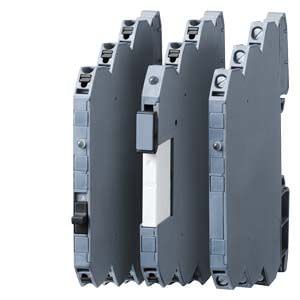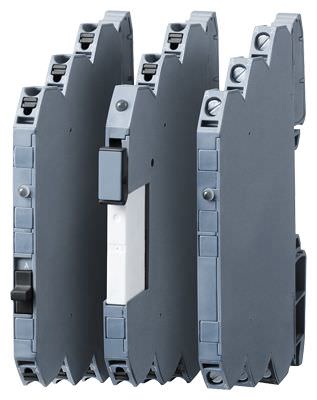SIRIUS 3RQ3 Coupling Relays, Narrow Design Siemens
- Relay Couplers with Relay Output
- Relay Couplers with Plug-In Design
- Optocouplers with Semiconductor Output
- Accessories

Область применения
- Galvanic isolation between input and output circuit
- Adjustment to different signal levels
- Signal amplification

Motor control application example
Обзор

SIRIUS 3RQ3 coupling relays
SIRUS 3RQ3 coupling relays in narrow design are used to connect control signals from and to a PLC, and they are available in different versions:
- Coupling relays with relay output (not plug-in)
- Coupling relays with plug-in relays
- Coupling relays with semiconductor output (not plug-in)
Coupling relays with relay output
AC and DC operation
IEC 60947‑5‑1, DIN EN 60947‑5‑1
The input and output coupling relays differ with regard to the positioning of the terminals and the LED.
Coupling relays with plug-in relays
AC and DC operation
IEC 60947‑1
These coupling relays are plug-in so that the relay can be replaced quickly at the end of its service life without detaching the wiring.
Coupling relays with semiconductor output
AC and DC operation
IEC 60947‑1, EN 60664‑1 and EN 50005;
Coupling relays with semiconductor output: EN 60747-5;
programmable controllers: IEC 61131‑2
The input and output coupling relays differ with regard to the positioning of the terminals and the LEDs.
The coupling relays with semiconductor output have extremely high contact reliability, and are therefore particularly well suited for solid-state systems.
For test purposes, versions are available with manual-0-automatic switches.
Spring-type terminal with push-in functionality
Push-in connections are a form of spring-loaded terminals allowing fast wiring without tools for rigid conductors or conductors equipped with end sleeves.
As with other spring-type terminals, a screwdriver (with 3.0 x 0.5 mm blade) is required to disconnect the conductor. The same tool can also be used to wire fine-stranded conductors with no end finishing.
The advantages of the push-in terminals are found, as with all spring-type terminals, in speed of assembly and disassembly and vibration-proof connection. There is no need for the checking and tightening required with screw terminals.
Note:
Conversion tool, e.g. from 3TX7 to 3RQ3, see www.siemens.com/sirius/conversion-tool.
Article No. scheme
Digit of the Article No. | 1st - 4th | 5th | 6th | 7th |
| 8th | 9th | 10th | 11th | 12th |
|---|---|---|---|---|---|---|---|---|---|---|
Coupling relays in the new 6.2 mm enclosure | 3RQ3 | |||||||||
Function | ❒ | |||||||||
Design and output type | ❒ | |||||||||
Switching current at the output | ❒ | |||||||||
Connection method | ❒ | |||||||||
Contacts | ❒ | |||||||||
Rated control supply voltage | ❒ | |||||||||
Max. switchable voltage at the output | ❒ | |||||||||
Contact variant | ❒ | |||||||||
Example | 3RQ3 | 1 | 1 | 8 | – | 1 | A | M | 0 | 0 |
Note:
The Article No. scheme is presented here merely for information purposes and for better understanding of the logic behind the article numbers.
Особенности
General
- All versions with screw or spring-type terminals (push-in technology)
- Top wiring with spring-type terminals (push-in) for fast and secure wiring.
- Low space requirements in the control cabinet thanks to a consistent width of 6.2 mm
- Reduced inventory due to low variance
- Functional state of the coupling relay clearly indicated by green LED
- Integrated reverse polarity protection and EMC arc-suppression diode
- Uniform accessories throughout the entire 3RQ3 series
- Integrated jumper option using connecting comb for all terminals
- Galvanic isolation plate for isolating different voltages for neighboring units
- Clip-on labels available as plotter matte paper for individual printing
Coupling relays with relay output
- Permanently soldered relays for increased contact reliability
- Device variants with hard gold-plated contacts providing high contact reliability at low currents
Coupling relays with plug-in relays
- Fast replacement of the relays with existing wiring
- Tested complete units → lower assembly time
- Individual relays available as spare parts
- Device variants with hard gold-plated contacts providing high contact reliability at low currents
Coupling relays with semiconductor output
- Long service life as there is no mechanical wear
- High switching frequency thanks to short make and break times
- Insensitive to vibrations
- No contact bounce
- Maximum contact reliability
- Noise-free switching
- Low control power required
- Switching of DC and capacitive loads







 Ответ от производителя может занять до 5 дней и более.
Ответ от производителя может занять до 5 дней и более.

